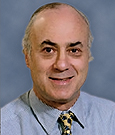“He gave his honours to the world again,
his blessed part to heaven, and slept in peace.”
—William Shakespeare, Henry VIII
In 1971, John M. Goldman, DM, FRCP, FRCPath, FMedSci, began research in chronic myeloid leukemia (CML), a uniformly fatal disease at the time. Over the ensuing decades, Dr. Goldman’s pioneering work in the laboratory and clinic was instrumental in turning CML into a controllable condition for many patients, saving countless thousands of lives. After a brief illness, Dr. Goldman died on December 24, 2013.
Dr. Goldman was the son of Jewish parents who fled from Germany to England in 1933 to escape the threat of the Nazi’s racial laws. They arrived in London with a £5 note and their worldly belongings in a suitcase. Dr. Goldman’s father Carl Heinz was a doctor, and he would go on to establish a successful practice in internal medicine. His status in the community allowed him to help many of his relatives escape Germany before the outbreak of war.
Early Career Highlights
Dr. Goldman was born in London, in 1938. An eager student, his academic skills propelled him through primary school toward an advanced degree. He attended Magdalen College, Oxford, to study classics, only later turning to medicine. Dr. Goldman did his medical training at St. Bartholomew Hospital in London.
A serendipitous opportunity brought him to the United States, where he took positions in hospitals in Miami and later at Harvard University. An avid flyer, Dr. Goldman also found time during this energized period in his career to obtain his pilot’s license.
Dr. Goldman eventually returned to his native Great Britain, and in 1971, he joined the prestigious group of hematologists in the Department of Hematology at Hammersmith Hospital in London. Internationally renowned for clinical research, Hammersmith Hospital is where Dr. Goldman began his work in CML, and it would serve as the base for his long and illustrious career.
In 1980 Dr. Goldman started allogeneic hematopoietic cell transplantation for patients with CML. He also initiated the use of unrelated donors for stem cell transplantation in CML patients and was at the forefront of developing polymerase chain reaction (PCR) technology for monitoring residual leukemia.
Along with research and clinical work, Dr. Goldman was a proactive figure in the international oncology community. Seeing an unmet demand in matching donors for CML patients needing transplantation, Dr. Goldman and his colleagues established the Anthony Nolan bone marrow register, which today includes more than 500,000 potential donors. Named for a boy who died at age 8 of Wiskott-Aldrich syndrome, a rare blood disorder, the Anthony Nolan register has been instrumental in helping CML patients in the United Kingdom as well as 15 other countries worldwide obtain lifesaving transplants.
Role in Imatinib Development
Dr. Goldman performed early clinical studies of the original tyrosine kinase inhibitor (STI571, imatinib), and he began using it in the clinic in 1999. He also vigorously promoted the research of Brian Druker, MD, who had helped develop imatinib.
Although the targeted agent produced substantial survival benefits in CML, major drug companies were reluctant to invest in developing a drug for a limited patient population of about 5,000 per year. Determined to see imatinib’s promise realized, Dr. Goldman flew to Novartis’s headquarters in Basel, Switzerland, and persuaded the company’s CEO to manufacture the drug. It has since become the oncology success story that researchers hope to replicate in other cancers.
Dr. Goldman was a founder of several professional societies that promoted research in blood cancers and transplantation, including the European Hematology Association and the European Group for Blood and Marrow Transplantation. He also created charities, such as Leuka, to help fund leukemia research. Dr. Goldman published more than 800 scientific papers and book chapters.
Worldwide Influence
Perhaps most telling about his devotion to CML patients was a statement by his friend and colleague, Robert Peter Gale, MD, PhD, Visiting Professor of Haematology at the Imperial College London: “His American medical colleagues thought nothing of calling John at 2:00 AM London time to discuss an idea or a complex medical case. No one is certain when (or if) he
ever slept.”
In the tributes for Dr. Goldman, the word “gentleman” is often mentioned. Besides being a renowned researcher and clinician, Dr. Goldman was a lover of life. He enjoyed traveling, reading, and skiing, and among those fortunate enough to call him their friend, he was known for his generosity and modesty. After his death, remembrances flooded in from across the globe. Websites such as that of the International Chronic Myeloid Leukemia Foundation carried hundreds of comments from doctors and patients.
One of his many mentees wrote, “John has mentored many hematologists and scientists over the past few decades. Their stories are deeply personal, but they have common themes. His influence was worldwide, as evidenced by the scores of influential scientists and clinicians that name him as their key mentor. John’s joy in scientific discovery will serve as an inspiration for us and the future generations of doctor-researchers.”
Dr. Goldman is survived by his wife, two daughters, and a son. His daughter Cassie carried his love of flying to greater heights—she’s a 747 pilot. The good doctor is also survived by the thousands of patients whose lives were made longer and better by his tireless work to cure leukemia. ■


